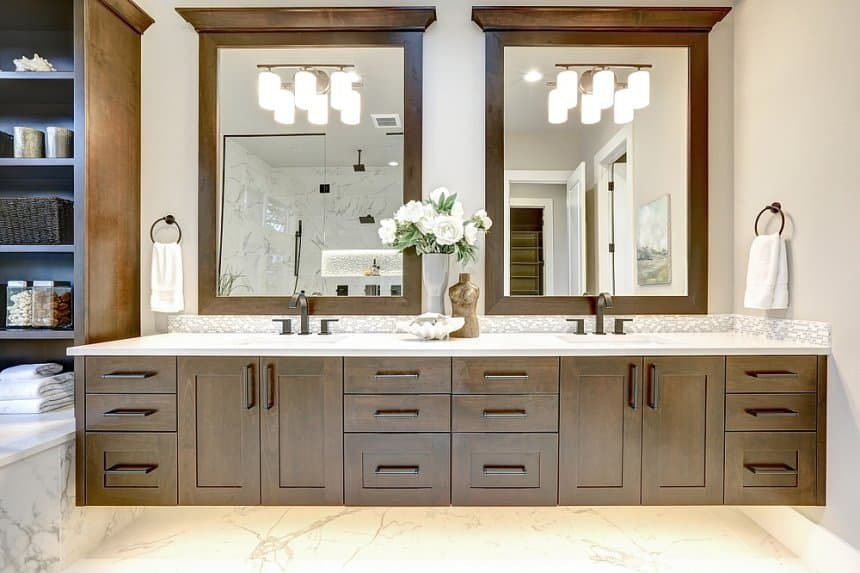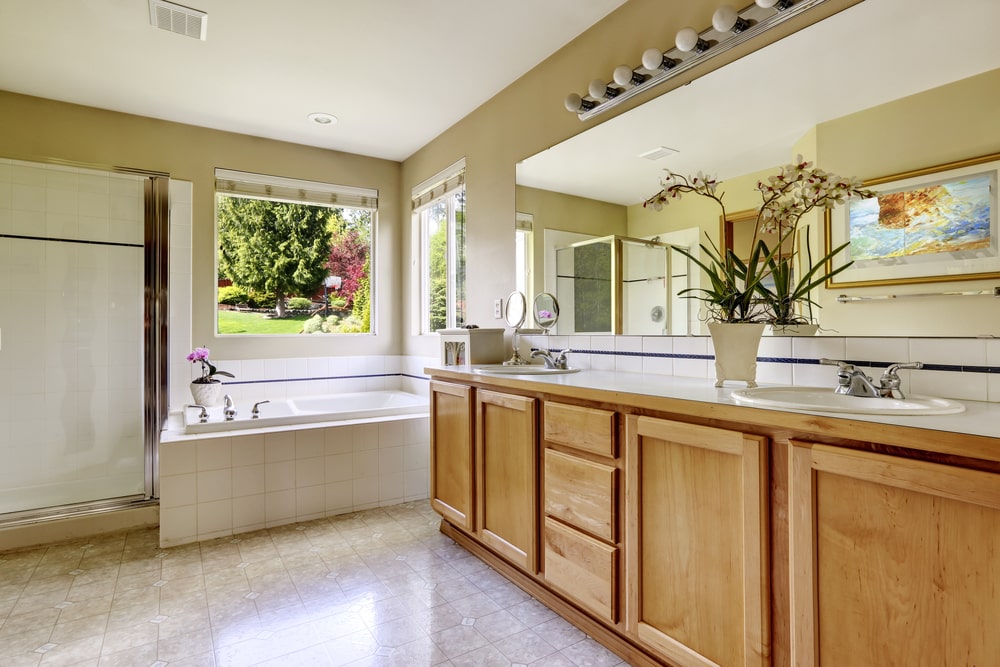Installation and Design Considerations: Reface Bathroom Vanity Cabinet

Transforming your bathroom with a Reface vanity cabinet is a rewarding project that blends style and functionality. This section delves into the practical aspects of installation and design considerations, guiding you through the process of seamlessly integrating a Reface vanity into your bathroom space.
Installation Guide
Installing a Reface vanity cabinet is a straightforward process that can be accomplished with basic tools and a little patience. Here is a step-by-step guide:
- Prepare the Area: Ensure the bathroom floor is level and clear of obstructions. Disconnect the water supply to the existing vanity. Remove the old vanity, taking note of the plumbing connections.
- Install the Vanity Cabinet: Position the new vanity cabinet in the desired location, ensuring it is level and centered. Use shims as needed to adjust the level.
- Connect the Plumbing: Connect the water supply lines to the new vanity’s faucet. Ensure the connections are secure and leak-free.
- Install the Sink: Attach the sink to the vanity countertop, following the manufacturer’s instructions.
- Install the Hardware: Install the cabinet’s knobs, pulls, and hinges.
- Connect the Drain: Attach the drain pipe to the sink and connect it to the bathroom’s drain system.
- Test for Leaks: Turn on the water supply and check for any leaks.
Bathroom Layout Design
Creating a bathroom layout that complements your Reface vanity cabinet involves considering factors like space limitations, plumbing access, and aesthetic preferences. Here are some design considerations:
- Space Optimization: In smaller bathrooms, a compact vanity with a smaller countertop can maximize floor space. In larger bathrooms, consider a double vanity for ample storage and counter space.
- Plumbing Access: Ensure the vanity’s location allows for easy access to the plumbing connections. Avoid placing the vanity directly in front of the toilet or shower to ensure ample movement space.
- Aesthetic Preferences: Choose a vanity style that complements your bathroom’s overall aesthetic. Consider the colors, finishes, and materials of your existing fixtures and decor.
Styles and Finishes
Reface bathroom vanity cabinets come in a variety of styles and finishes to suit different bathroom aesthetics.
- Contemporary: Contemporary vanities often feature clean lines, minimalist designs, and sleek finishes like chrome or brushed nickel.
- Traditional: Traditional vanities often have ornate details, classic shapes, and finishes like brass or antique bronze.
- Transitional: Transitional vanities blend elements of contemporary and traditional styles, creating a harmonious balance between modern and classic designs.
Hardware Options
The hardware you choose for your Reface vanity cabinet can significantly impact its overall aesthetic.
| Hardware Type | Styles | Materials |
|---|---|---|
| Knobs | Round, square, crystal, ceramic | Brass, chrome, nickel, bronze |
| Pulls | Bar, cup, cabinet, edge | Brass, chrome, nickel, bronze |
| Hinges | Soft-close, concealed, surface-mounted | Brass, chrome, nickel |
Maintenance and Care

A reface bathroom vanity cabinet, like any other piece of furniture, requires proper care and maintenance to ensure its longevity and preserve its beauty. By following a few simple tips, you can keep your reface vanity looking its best for years to come.
Cleaning and Maintenance, Reface bathroom vanity cabinet
Regular cleaning is essential for maintaining the appearance and functionality of your reface vanity. Dusting and wiping down the surfaces with a damp cloth can prevent dirt and grime buildup.
- For everyday cleaning, use a mild soap and water solution. Avoid harsh chemicals or abrasive cleaners that can damage the finish.
- Wipe down the cabinet with a soft cloth after cleaning to prevent watermarks or streaks.
- If you have a laminate or painted finish, you can use a furniture polish to add shine and protect the surface.
- Clean the hardware regularly, using a soft cloth and a mild soap solution. Avoid using abrasive cleaners or harsh chemicals that can damage the finish.
Common Problems and Solutions
Over time, your reface bathroom vanity may experience some common problems, such as scratches, dents, or loose hardware.
- Scratches: Minor scratches can often be removed with a furniture polish or a touch-up pen that matches the cabinet’s finish. For deeper scratches, consider using a wood filler or a paint pen to repair the damage.
- Dents: Small dents can sometimes be removed by gently applying heat with a hairdryer. Larger dents may require professional repair.
- Loose Hardware: Tighten loose screws or replace damaged hardware as needed.
Repairing Minor Damages
Minor damages, such as scratches or dents, can be repaired at home with a few simple tools and supplies.
- Scratches: For minor scratches, a furniture polish or a touch-up pen can often blend the scratch with the surrounding surface. If the scratch is deeper, consider using a wood filler or a paint pen to repair the damage.
- Dents: Small dents can sometimes be removed by gently applying heat with a hairdryer. This can help to soften the wood and allow the dent to pop out. For larger dents, professional repair may be necessary.
Importance of Using the Right Cleaning Products
Using the right cleaning products is crucial for maintaining the finish and longevity of your reface bathroom vanity.
- Avoid harsh chemicals: Harsh chemicals, such as bleach or ammonia, can damage the finish of your vanity. They can strip away the protective coating and leave the surface vulnerable to scratches and stains.
- Use mild soap and water: A mild soap and water solution is generally sufficient for cleaning your reface bathroom vanity. This will help to remove dirt and grime without damaging the finish.
- Consider using a furniture polish: For laminate or painted finishes, a furniture polish can help to add shine and protect the surface from scratches and water damage.
Reface bathroom vanity cabinet – Refacing a bathroom vanity cabinet can be a budget-friendly way to give your space a fresh look. The process involves updating the cabinet doors, drawer fronts, and countertop with new materials. This can be a great way to transform a tired bathroom into a modern oasis, similar to the luxurious feel of a 2 bedroom junior connecting suite Disneyland hotel , where every detail is designed for comfort and enjoyment.
Refacing is a relatively simple DIY project that can be accomplished with basic tools and a little patience, allowing you to enjoy the satisfaction of creating a beautiful and functional bathroom space.
Refacing a bathroom vanity cabinet can be a cost-effective way to update its look, but sometimes a complete replacement is necessary. If you’re working with limited space, consider a 23 inch bathroom cabinet which can offer ample storage while maximizing floor space.
These compact cabinets are perfect for smaller bathrooms, and refacing can further personalize their style to complement your bathroom’s overall design.
